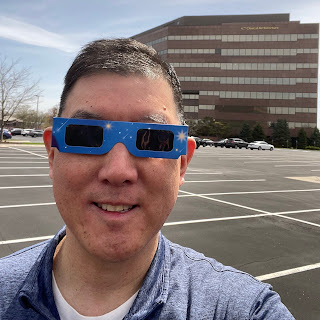I was fortunate enough to experience the 2024 Total Solar Eclipse from Carmel, Indiana. While I was able to view the eclipse through my eclipse glasses, I also brought various recording devices to capture my surroundings from multiple perspectives. This blog entry provides some information about my setup.
Location, Location, Location. The first consideration, aside from being in the path of totality, was to determine the exact location from where I’d view the eclipse. I decided that in addition to directly recording the sun itself, it would be interesting to record the office building where I work—right before, during, and right after totality. From the parking lot (pictured above), I was able to get a good angle of the building, free from obstruction, as well as an unobstructed view of the sun.
Timing. For most people, an approximate time for the start and end or totality would suffice. Most eclipse viewers simply need to arrive before totality and might snap a few photos and videos to commemorate the event. I was slightly more constrained because I needed to ensure that I had sufficient storage space on my memory cards as well as battery life to capture my intended footage. To determine the precise start and end of the partial and total eclipse, I used the US Navy Solar Eclipse Computer. I grabbed GPS coordinates from Google Maps and entered them into the Solar Eclipse Computer but had to truncate them after 4 decimal places. I made sure to arrive shortly after the beginning of the partial eclipse which would give me an hour to get situated, look around, and set up all my equipment to prepare for totality.
GoPro. One of my recording devices was my GoPro HERO7 Black which I simply affixed to a 3D printed mount and placed on the hood of my rental car since it was one of the only objects above ground level. The purpose of the GoPro was to record a video of the office building and produce a timelapse video immediately before, during, and immediately after the 3.5 minutes of totality. I wasn’t able to attach the mount to anything, and despite there being a slight breeze, I was fairly confident that it would not move around during recording. Given my familiarity with my GoPro’s battery life, I began recording about 10 minutes before the onset of totality, as I was confident that I’d have more than enough RAM and battery life to capture all of totality and several minutes afterward.
Drone. My 2nd recording device was a DJI Mavic Mini. Its purpose was also to obtain a timelapse of the building but from a higher perspective. Approximately 7 or 8 minutes before totality, I flew the drone to 18 meters (59 feet) altitude, according to the flight data, and started recording. I simply allowed the drone to hover for the entire duration. While the drone stayed put for the most part, the 10x timelapse shows what looks like noticeable movement of the drone in all 3 axes which gave the building a “rubbery” appearance. I don’t know how much of this movement was due to the wind. In any case, I was happy with my timing, as the battery lasted through totality and plenty of time thereafter.
Camcorder. My 3rd recording device was a Canon VIXIA HF M301 camcorder with 15x optical zoom capabilities. Along with my eclipse glasses came a camera filter which was probably intended to be used with mobile phones, but the diameter of the filter was sufficient to cover the entirety of the camcorder lens. I used 2 pieces of clear tape to attach the filter to the camcorder so that it fully covered lens. I mounted the camcorder to a portable tripod and placed the tripod on a folding chair, mainly for the purpose of elevating it off the pavement of the parking lot so it was easier for me to make adjustments. Given that I had zoomed all the way to 15x, I discovered that I was only able to capture the sun for a few minutes at a time before it moved off frame. Therefore, I had to keep repositioning the camcorder before, during, and after totality. This meant that I was unable to capture a continuous uninterrupted video of the eclipse. Maybe next time I’ll consider investing in a solar photography tracking mount, but I was mostly satisfied with the results that I got without one. I noticed that when the sun was closer to the edges of the frame, the camcorder had difficulty auto-focusing on the sun, but that was not surprising.
The one obvious missing recording device was my Canon R6 full frame mirrorless camera which I alluded to here. I expected to have my hands full with all the recording devices above, and the addition of my R6 camera and another tripod would have added significantly to my luggage. Therefore, I made the difficult but practical decision to leave it at home. Maybe I’ll bring my “big” camera to a future solar eclipse. Overall, I was happy with the amount of planning that I put into this momentous occasion, and I was blessed with fairly clear skies and good weather, all of which amounted to an unforgettable event. You can enjoy my eclipse video here and below:


